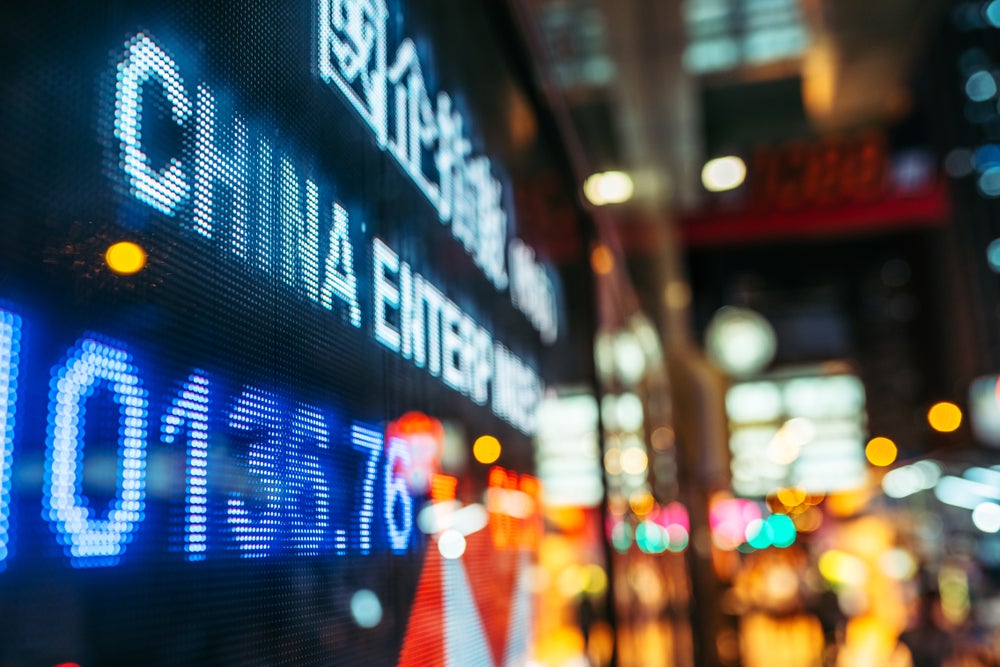
Companies have reason to be sceptical about investment in Asia in general and in China in particular. In China, Beijing is tightening its grip on its thriving tech industry, forcing companies like Alipay to hold off on their public debuts, launching probes against companies like Didi Chuxing and restricting domestic startups’ ability to list abroad.
However, the question is if things really are as bad as they may seem. After all, in many ways the Asian markets have weathered the turmoil of the last 18 months better than other regions of the world.

Access deeper industry intelligence
Experience unmatched clarity with a single platform that combines unique data, AI, and human expertise.
Take mergers and acquisition (MA) deals for example. Given the pandemic, it shouldn’t come as a shock that 2020 wasn’t the best year for MA deals. A GlobalData review reports that $2.87bn worth of M&A deals were announced last year across the globe, a decline of 5.4% from 2019. Deal volume also posted a year-on-year (YoY) decline of 4.8%. However, investment in Asia tells a very different story.
Here’s where it gets interesting: the same report notes that while deal activity remained muted across most regions, Asia-Pacific (APAC) was the only region that managed to witness growth in deal value as well as volume. Total deal value and volume for the APAC market increased from 6,594 deals worth $486bn in 2019 to 7,621 deals worth $666bn, a 15.6% and 37.0% increase respectively. The region’s technology sector led the way with a 121% growth in tech deal value and a 45% jump in deal volume.
GlobalData puts down this success to the fact that several APAC economies managed to control the spread of Covid-19 and recover relatively faster compared to the rest of the world. China in particular led the way on this front and accordingly led M&A deal activity during the first two quarters of 2020 when the pandemic and related uncertainty was gaining strong momentum.
This, contrary to any pandemic-related misgivings, could suggest that expanding tech companies looking to up Asia investment would do well in setting up a base in China.

US Tariffs are shifting - will you react or anticipate?
Don’t let policy changes catch you off guard. Stay proactive with real-time data and expert analysis.
By GlobalDataPioneer Payoneer
One company who did this long before Covid was commerce tech brand Payoneer, headquartered in New York and which opened its first APAC offices in Hong Kong in 2015. Since then the company has opened three offices in mainland China: in Shenzhen, Shanghai and Guangzhou.
“Opening an office in China was a natural step for us as China is a world leader when it comes to cross-border ecommerce and has been for years”, says Charles Rosenblatt, Payoneer’s chief strategy officer.
“As the world enters a new era of commerce, China remains on the leading edge of digital and borderless trade. Today, there’s a new focus in China on social commerce – livestreaming, gaming and more. We expect to see other countries quickly follow suit.
“While we do have other offices in countries throughout the APAC region, China is a crucial hub as sellers based in other countries throughout Asia and beyond look to China for guidance on how to grow their own cross-border sales.”
Rosenblatt believes the pandemic showed this power in action. When the shutdown of the Chinese economy impacted commerce all over the world as almost all major manufacturers are heavily reliant on Chinese supply chains and businesses.
But speaking with other industry insiders, Verdict finds a more complicated picture of the Asian region emerging, one that presents various options for technology brands looking to expand into APAC.
Asia investment and the Great China Flight
Covid-19 may have shown China’s resilience in tech and pandemic handling, but other factors mean companies aren’t necessarily scrambling to open bases in Shanghai or Beijing. Hong Kong too has lost some of its lustre in attracting outside business, with the number of foreign company offices there having fallen in 2020 for the first time in 11 years.
The exodus is caused by a number of reasons. These include China’s controversial national security law, a new data security law forcing Big Tech to share information with the government and the increasing influence of tech hub Shenzhen.
Hong Kong, though, was never a technological stronghold to begin with. Instead, it offered a chance for businesses to make money at China and APAC’s doorstep with little regulation, much like Singapore. But companies are feeling spooked and leaving the mainland, with US companies leaving China due to the ongoing trade war, whilst big names like Dell, HP, Alphabet, Microsoft, Intel and GoPro downsized or are rumoured to be downsizing Chinese manufacturing.
Asian companies are doing the same: South Korean giant Samsung Electronics shut its last Chinese smartphone, TV and PC factories in 2019, while Kia and Hyundai have closed key car manufacturing plants in the People’s Republic.
While LG and Hyundai Mobis have both done the same and ramped up manufacturing in the Republic of Korea, most APAC tech brands are moving manufacturing to Southeast Asia (SEA), with Samsung, Sony and Nintendo moving to Vietnam, joining US plants from Intel, Microsoft, Apple and Alphabet. Thailand is also getting some investment from Sony, Apple and Alphabet.
Singapore (Nedla/Shutterstock)
Asia investment: It’s coming home?
Taiwan, comfortably situated between East Asia and SEA, has also seen homegrown hardware makers like Quanta Computer, Asus and bike/e-mobility brand Giant bolster factories back home, adding $9.2bn to the Taiwanese economy last year. According to Jeremy Olivier, senior editor of Taiwan Business TOPICS, this is down to the US-China trade dispute forcing a large number of Taiwanese businesses with operations in China to reconsider the extent of those operations.
“Many began relocating some or all of their production to Taiwan or other locations in SEA,” Olivier tells Verdict. “InvesTaiwan, an office under the Ministry of Economic Affairs, reports that programmes it launched in 2019 to take advantage of this trend have to date attracted over NT$1tn in actual and pledged investment.
“Considering the rising costs of labour and raw materials in China and the increasingly less hospitable environment for foreign businesses there, we are likely to see this pattern continue.”
But while Taiwan arguably weathered Covid better than China or any other country in the world, the country isn’t yet replacing Hong Kong, Singapore or even China in the eyes of foreign tech names looking to increase Asia investment.
Mark Stocker, founder of DDG (Direction Design Group), a leading brand consultancy based in Taipei and previously Shanghai, notes that while international news outlets like The New York Times are leaving Hong Kong for elsewhere, he feels corporations “are still very much interested in opportunities in China.”
“There is some level of diversification within manufacturing, particularly in the technology space,” he adds, “but this doesn’t mean companies are pursuing a wholesale exit from China.”
Olivier notes that while multinationals have long viewed Taiwan as an ideal place to invest, expand operations and do business in, he hasn’t seen a marked uptick in the number of international companies looking to open or relocate regional HQs in the island nation.
“However, the interest in starting or increasing investment on the island has definitely shot up in the past few years, particularly in the tech (R&D) and renewable energy sectors,” he adds.
“This can clearly be seen in the recent major investments made by companies such as Microsoft and Google, which plan to open large R&D and data centres in Taiwan, as well as offshore wind developers like Ørsted, whose wind farms off the coast of (the county) Changhua are set to power the fabs of Taiwan’s ‘silicon shield,’ TSMC.”
With its semiconductor prowess amidst the ongoing worldwide chip shortage, Taiwan already holds a lot of power and attraction on the tech stage; Olivier notes the city of Hsinchu as being the centre of Taiwan’s tech and semiconductor ecosystem.
“Another major location is Taoyuan, which is working hard to attract investment with its Aerotropolis development project. In addition, I’ve heard it mentioned recently that the next several years will be a ‘golden age’ for high-tech development in southern Taiwan.
“Both Tainan and Kaohsiung (cities in the south) are home to separate campuses of the Southern Taiwan Science Park and given that the north is becoming overbuilt and more land is available down south, this area could very well become a hotspot for Taiwan’s tech industry in the coming years.”
Wind farm in Taiwan (Photo by Craig Ferguson/LightRocket via Getty Images)
Dragons in the Lion City
For all of China and Taiwan’s power though, SEA seems to be the hotspot for Asia investment in technology, especially fintech. London-headquartered Napier for example, a provider of artificial intelligence (AI) infused regulation technology solutions, opened a second APAC office this year in Kuala Lumpur, joining in the region Napier’s Singapore base which opened in 2020.
Singapore has also attracted Icelandic fintech Meniga to open its first APAC base, where it has launched banking apps for the likes of Singaporean multinational banking group UOB.
So what makes the Lion City stand out above other cities in the region? For Stocker, it’s all about marketing.
“Singapore has certainly done a better job than Taiwan and Japan in building an image as a safe-haven for corporate and personal finances,” says the DDG founder. “There is this impression that Singapore serves as a gateway to the world financially, much like Hong Kong, where your money will be free to move anywhere. Although other countries offer the same freedom of financial movement, there isn’t so much this impression with Taiwan, Korea and Japan.
“Another concern for Taiwan, true or not, is that no one is capable of saying whether or not Taiwan is only a few years or decades behind Hong Kong in terms of its integration with China, and that each new election in Taiwan opens the doors to a change in the current relationship. Singapore isn’t in this situation, and for this reason, is probably seen as a safer long-term bet.”
For Robin Lee, head of APAC at Napier, the Singapore and Malaysia move brings the brand closer to customers that operate both locally in the region and across global markets: banks, payment providers, FX and other financial services companies.
“While our customers can be based or operate right across Asia Pacific,” Lee tells Verdict, “we chose Singapore and Kuala Lumpur because of the ease of doing international business in both places. They both have really exciting tech cultures that help to drive innovation, and with that we’ve also got a wonderful pool of talent from which to recruit.”
Georg Ludviksson, CEO and co-founder of Meniga, tells Verdict that Napier’s partnership with the bank, one of the largest in Asia, prompted the APAC market expansion. He also says the island state lies “at the heart of one of the most advanced fintech ecosystems in the world”, SEA, implying perhaps this APAC subregion offers a more exciting prospect than the Eastern leaders of China, Japan and South Korea.
“Singapore also has a demographic of digitally-connected and tech-savvy millennials, which offers a perfect testbed for our solutions,” adds Ludviksson.
“Since opening (the office) back in 2019, our footprint in the region has gone from strength to strength. Beyond helping UOB roll out the first gamified digital bank of Southeast Asia across Thailand and Indonesia, (we assisted) in the launch of UOB’s Mighty app across Singapore and Malaysia.”

The CEO, picture above, is confident Meniga will soon be introducing digital banking solutions to “many more markets” in APAC, leading Verdict to ask where China fits in that picture.
“Although we have no immediate plans to expand to China, we are always on the lookout for new innovative banking partners around the world, and are currently in talks with several other banks across Asia.
“That said, our areas of focus are [to keep] expanding the global footprint of our green banking solution Carbon Insight, which integrates into banks’ digital properties and allows its mobile app users to track their carbon footprint based on their spending data.
“With China being home to a growing population of carbon-conscious consumers and numerous innovative and forward-thinking banks, it would be hard to rule out launching (our solution) in the Chinese market in the near future.”
For Napier’s Lee, China is “definitely an important market” and the brand is already working with Chinese customers, including government institutions, to combat financial crime.
“A dedicated China base would be extremely viable and something that we will no doubt look towards,” he adds.
Setting up in China though may be trickier than doing so in Singapore and also Taiwan, according to DDG’s Stocker.
“We set up the Shanghai office nine years ago,” says the MD about DDG’s China footprint, which wound down this year due to Covid impact. “The process was not dissimilar to Taiwan, however there were a lot more hoops to jump through in terms of setting up bank accounts, setting up with various government departments, signing on employees (insurance, etc.)
“Overall, I feel that one finds the government departmental staff here in Taiwan more willing to assist you through the process, where in China there is less interest in helping you with the process,” Stocker continues, adding also that DDG had great assistance from a local Shanghai accounting firm for the process back in 2012.
From Payoneer CSO Rosenblatt, the advice for foreign companies looking to join his brand in China is that the transition isn’t as hard as controversy about the country may make it look.
“There is definitely a certain mystique around doing business in China, but the reality on the ground is that operating in China is no different to entering any other market,” he tells Verdict. “You have to understand your customers, be where they are, speak their language, follow local regulations and adapt to local business needs.
“For example, consumers and businesses in Asia use far more diverse payment options than their counterparts in the US and Europe; in order to flourish in China and greater Asia, being able to offer a variety of local payment methods is crucial.
“The key is putting people where your customers are, so you can be truly global and local at the same time.”
Find the GlobalData Global and Region M&A Report: Financial & Legal Adviser League Tables 2020 here.









